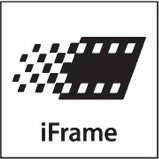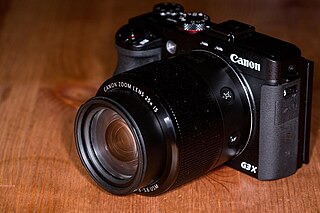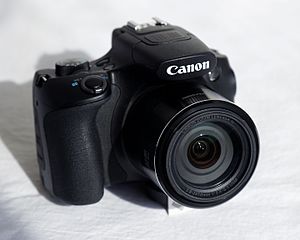
The Digital IXUS is a series of digital cameras released by Canon. It is a line of ultracompact cameras, originally based on the design of Canon's IXUS/IXY/ELPH line of APS cameras.

The Canon PowerShot G is a series of digital cameras introduced by Canon in its PowerShot line in 2000. The G series cameras are Canon's flagship compact models aimed at photography enthusiasts desiring more flexibility than a point-and-shoot without the bulk of a digital single-lens reflex camera.

Bridge cameras are cameras that fill the niche between relatively simple point-and-shoot cameras and interchangeable-lens cameras such as mirrorless cameras and single-lens reflex cameras (SLRs). They are often comparable in size and weight to the smallest digital SLRs (DSLR), but lack interchangeable lenses, and almost all digital bridge cameras lack an optical viewfinder system. The phrase "bridge camera" has been in use at least since the 1980s, and continues to be used with digital cameras. The term was originally used to refer to film cameras which "bridged the gap" between point-and-shoot cameras and SLRs.
The Canon PowerShot S is a series of digital cameras released by Canon, as part of the wider PowerShot range. The S-series was originally a line of compact point-and-shoot cameras, slowly evolving into a prosumer line of cameras slotting right beneath the G-series cameras. The line later branched off into Canon's line of super-zoom cameras. The PowerShot ELPH line is a branch of the S-series, due to its model number designations in the United States, as well as the similarities between the PowerShot ELPH S100 and the PowerShot S10

The PowerShot products is a line of consumer and prosumer grade digital cameras, launched by Canon in 1996. In 1996 a model of PowerShot was introduced to the market, The Powershot 600. The production of The PowerShort came shortly after Canon released and subsequently discounted its SV series in 1992 and switched to digital cameras. The PowerShot line has been successful for Canon, and is one of the best-selling digital camera lines worldwide. The Powershot's success comes its marketing to the general public as a compact and easy to use digital camera.

Digital Imaging Integrated Circuit is Canon Inc.'s name for a family of signal processing and control units for digital cameras and camcorders. DIGIC units are used as image processors by Canon in its own digital imaging products. Several generations of DIGICs exist, and are distinguished by a version number suffix.
DRYOS is a real-time operating system made by Canon and is used in their latest digital cameras and camcorders.

An articulating screen is a built-in small electronic visual display which is not fixed, but rather can be repositioned using a hinge or pivot. The articulating screen is known under different other names such as flip-out screen, flip screen, adjustable screen, articulated screen, or hinged screen. According to the way it moves, there are four main types:
- The display moves around one axis, so that it only tilts. It is called tilting screen or tiltable screen.
- The display tilts horizontally both up and down and also vertically. This type is called double-hinged tilting screen, two-axis tilting screen, three-direction tilting screen or screen with 3-way tilt.
- The display moves around two axes which are at a right angle to each other, so that the screen both tilts and swivels. This type is called swivel screen. Other names for this type are vari-angle screen, fully articulated screen, fully articulating screen, rotating screen, multi-angle screen, variable angle screen, flip-out-and-twist screen, twist-and-tilt screen and swing-and-tilt screen.
- The display is mounted on a fully-articulating hinge that itself is attached to a tilting plate. Such display can be extended out from the back of the camera, ensuring it stays clear of the camera's left-mounted ports when flipping it out to the side. This type of articulating screen is called tilt-and-articulating screen.
- The display moves into a variety of angles; it tilts horizontally and vertically and also rotates to a certain extent while staying aligned with the lens axis. It still can not be turned all the way up, down or to the side to be seen from the front of the camera for self-portraits. This type of articulating screen is called cross-tilt screen, flexible-tilt screen or flex-tilt screen.

iFrame is a digital video format developed by Apple. It is based on existing industry standards, such as AVC/H.264, AAC and QuickTime, and can be used with compatible Mac and PC applications.

The Fujifilm FinePix HS10 is an ultrazoom bridge camera from Fujifilm that was announced in February 2010. It is the first model of the Fujifilm FinePix HS series.
The Panasonic Lumix DMC-FZ70 or Panasonic Lumix DMC-FZ72 is a DSLR-like ultrazoom bridge camera announced by Panasonic on July 18, 2013. It succeeds the Panasonic Lumix DMC-FZ62. FZ70 and FZ72 refer to the same camera model in different markets. The FZ70/72 has a 16 megapixel sensor and 20-1200mm equivalent, 60x optical zoom lens. Its successor is the FZ82 with a 18 megapixel sensor, 4K video and the same 60x optical zoom lens.

The Canon PowerShot SX50 HS is a 12.1 megapixel PowerShot model camera made by Canon. It features a large built-in 50x zoom lens which is equivalent to a focal length of 24-1200mm. Succeeding the Canon PowerShot SX40 HS, it was announced in October 2012. It was succeeded by the Canon PowerShot SX60 HS in September 2014.
The Canon SX280 HS compact camera is a compact zoom camera created by Canon. The camera has a 20X zoom, has GPS and records in full HD video.

The Fujifilm FinePix HS50EXR is a DSLR styled ultra-zoom bridge camera announced by Fujifilm on January 7, 2013. It is the last model of the Fujifilm FinePix HS series. At the time of its release, it competed most closely with the Canon PowerShot SX50 HS, another ultra-zoom bridge camera with raw capability. The SX50 has 20% longer maximum effective focal length, but the HS50 has 33% more resolution on the sensor.
The Canon PowerShot SX520 HS is a digital compact camera announced by Canon Inc. on July 29, 2014. The point-and-shoot superzoom camera has a 16 megapixel sensor, 42x optical zoom, and full 1080p HD video capabilities. It replaced the SX 510 HS from previous year. The zoom was increased from 30x to 42x but unlike SX510 HS it does not support WiFi transfer for images and videos.

The Canon PowerShot G3 X is a large sensor digital bridge camera announced by Canon on June 18, 2015. It marks Canon's entry into this product category, alongside competitors such as the Panasonic Lumix DMC-FZ1000, Sony Cyber-shot RX10 and RX10 II.











